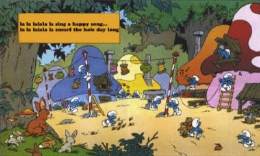The Smurfs life cycle.
The Smurfs are a relatively uncommon woodland animal, found mostly in heavy underbrush in moderately temperate zones. A typical grouping looks similar to this:

Smurfs are small, and are often preyed upon by larger animals, but their sheer numbers often dissuade predators, causing them to look for easier kills.
The exception to this rule are Gargamels, solitary creatures often found in close proximity to Smurf nests:

Gargamels can often be found making their lairs in old, rundown buildings, and are usually accompanied by Azraels, feline creatures that live in symbiotic relationships with Gargarmels. These creatures are the only known natural enemies of Smurfs, as it appears they lack the cognitive abilities to recognize the numbers of the Smurfs as a threat to their well-being. They prefer Smurfs to all other foods, but their lack of hunting ability often results in Gargamels and any accompanying Azraels being weak and sickly.
Gargamels generally find themselves as prey for Bigmouths:

Like the Gargamels, Bigmouths are solitary creatures, as their voracious appetites and highly competitive behavior require large grazing areas away from any other Bigmouths that may impact the food supply.
Bigmouths have no natural predators, and usually only die from 1) old age, or 2) overeating. Dead Bigmouths do not go to waste, however; within hours of a Bigmouth’s demise, the body can be found swarming with Smurfs, gorging themselves on the decaying flesh.
Not all of the meat is devoured. The Smurf Queen, or “Smurfette” as she is known colloquially, will deposit her eggs into the remnants of the Bigmouth’s body.

Within 24-48 hours, the eggs hatch, and the wormlike Smurf larvae feed upon what’s left of the Bigmouth. The Smurf-blown corpse of the Bigmouth serves yet another purpose, as the remains also serve as fertilizer, feeding the unusually large mushrooms that are native to Smurf forests. The engorged Smurf larvae burrow into these mushrooms, hollowing them out as they grow, and continue to use the excavated mushrooms as nests upon reaching maturity:

The cycle of life is truly a smurfy thing. I trust you found this informative.








[…] Additional Smurf information: Little Known Smurfy traits, the Smurf Life Cycle. […]
[…] Probably not featured in the book: this. […]
Lol.This had me laughing for a good couple of minutes.